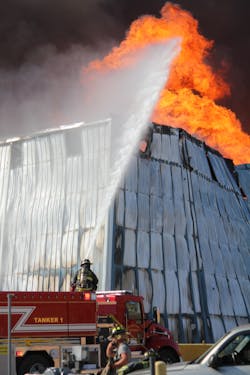HAZLEHURST/JEFF DAVIS COUNTY FIRE DEPARTMENT
Chief: Charles Wasdin
Personnel: 9 career firefighters, 73 volunteer firefighters
Stations: 2 city, 5 county
Apparatus: 9 pumpers, 5 tankers, 2 brush engines, 2 rescues, 5 brush trucks, 1 mobile command post
Population: 15,080
Area: 336 square miles
Thirty-eight fire departments responded to a five-alarm fire that destroyed one building and five million board feet of finished hardwood lumber at Thompson Hardwoods in Hazlehurst, GA, on June 9, 2014. After an offensive attack was begun, a switch to defensive operations was ordered to protect the company’s sawmill and millions more board feet of stored lumber.
“There was too much fire and too many BTUs and not enough water supply to stop the fire from destroying the warehouse and office building,” Hazlehurst/Jeff Davis County Fire Chief Charles Wasdin said.
The 225,000-square-foot metal frame building, erected in 2010, contained company offices and a warehouse for finished lumber. The 20-foot-high building had metal walls and a metal roof. Finished lumber was stacked 18 feet high inside. There were no fire protection or detection systems in the building, but there were several two-inch standpipes. More than five million board feet of finished hardwood lumber was destroyed. Company officials said it would have taken 635 tractor-trailers to transport all of the lumber destroyed in the fire.
Initial dispatch
The Hazlehurst/Jeff Davis County Fire Department was dispatched to a reported fire at Thompson Hardwoods at 600 Baxley Highway at 7:31 A.M. Responding on the initial alarm were Engines 2 and 31 and Tankers 1 and 2 with 12 firefighters under the Wasdin’s command.
First-arriving firefighters found heavy smoke and fire showing in the west rear area of the warehouse. All employees had been evacuated to pre-designated safe areas prior to the arrival of the fire department. Tanker 2 was positioned at the rear of the warehouse on the west side and set up for an interior attack. Firefighters advanced a 200-foot, 1¾-inch line from this unit. Engine 2 set up at the rear of the warehouse on the east side to protect the non-burning side of the building. Firefighters deployed two 200-foot, 1¾-inch lines and one 2½-inch line. Tanker 1 was positioned midway on the west side of the warehouse and attacked the fire in an effort to stop it from spreading the rest of the way through the warehouse. Firefighters placed two 200 foot, 1¾-inch lines and one, 150-foot, 2½-inch line from this unit. Engine 31 laid 800 feet of three-inch supply line to Tanker 1 from the only hydrant in the immediate area. This hydrant was on a six-inch dead-end water main.
Wasdin requested the second through the fifth alarms at 7:45 A.M. The second alarm brought Hazlehurst/Jeff Davis County Tankers 21, 32 and Tanker 33, Engine 41 and Truck 43 (a tanker) to the scene. Mutual aid included four engines and three tankers from the Georgia Department of Corrections; two engines and three tankers from Alma/Bacon County Fire; one engine each from the Alston, Cedar Crossing, Eastman, Jacksonville, Lyons, Swainsboro/Emanual County, Vidalia and Walthour fire departments; a 100-foot ladder truck from the Douglas Fire Department; three tankers each from the from the Appling County and Toombs fire departments; two tankers each from the Bulloch County, Crosswood, Graham and Ware County fire departments; one engine and one tanker each from the Baxley and Pulaski County fire departments; one tanker each from the Altamaha, Chauncey, Claxton, Coffee County, Eastern District, Horse Creek, Laurens County, Lumber City, Midway, Milan, Scotland, Springhill and Ten Mile fire departments; and manpower from the Dublin, Fitzgerald and Hinesville fire departments.
Offensive operations
The building was divided into four zones for operations. Interior operations in Zones 2, 3 and 4 continued for approximately two hours. Operations in Zone 1continued for approximately 15 hours. This let company officials remove computers, files and other contents. Operations in Zone 1 were supported by Hazlehurst Engine 2 as well as engines from Baxley and Alma/Bacon County. Firefighters deployed three 1¾-inch lines and one 2½-inch line in this zone. Tankers supplied water for operations. An engine from McRae/Telfair County arrived at arrived at 8:18 and was assigned to Zone 2, where firefighters placed two 1¾-inch lines into operation. This engine was supplied by multiple tankers.
Apparatus assigned to Zone 3 operations were an engine from Graham and Douglas Ladder 1. A 2½-inch line was operated from the Graham engine, which also supplied Douglas’ aerial master stream. This engine was supplied by multiple tankers. Zone 4 operations were assigned to Hazlehurst Engine 31 and Tanker 1. Two 1¾-inch lines and one 2½-inch line were operated from these units.
“The interior operation was to keep the fire from getting to a piece of equipment in the very southeast corner of the building (that was worth) several million dollar,” Wasdin said. “We were not moving forward in that area; we were just holding ground.”
Defensive operations
After conferring with company officials, Wasdin ordered firefighters to switch to defensive operations at 9 A.M. It was decided to try and save the sawmill and the millions of board feet of lumber that was stacked and stored around the outside of the building. Wasdin said the structure began to collapse at 8:13 A.M. About 50% of Zone 1 never collapsed and the rest of structure was on the ground by noon.
Initially, some tankers were filling from hydrants across Highway 341. These hydrants were on a dead-end six-inch main that flowed less than 500 gpm. This fill site was ineffective as it was taking too long to fill tankers, so four other tanker fill sites were established. Three hydrants 1½ miles away in Hazlehurst were used. The other fill site was a hydrant on the Graham Water System that was 1.2 miles away.
Dump sites were established for Zones 1 and 3. Zone 1 had two 2,000-gallon dump tanks set up. Bacon County Engine 21 was set up for drafting operations. Engine 21 supplied Baxley Engine 327 with a 100-foot, three-inch line and Hazlehurst Engine 2 with a 100-foot, three-inch line. Multiple 1¾-inch and 2½-inch lines were supplied by these units. Zone 3 had one 1,500-gallon dump tank set up. Graham Truck 1573 was set up as the draft engine. Douglas Ladder 1 was set up for aerial master stream operations. Truck 1573 supplied Douglas Ladder 1 with a 200-foot, 2 ½-inch line.
Water was supplied to Zone 4 from a hydrant on the premises. This hydrant was on a six-inch dead-end line and supplied less than 500 gpm. Jeff Davis County Engine 31 hooked onto the hydrant with two 2½-inch lines and pumped to Jeff Davis County Tanker 1 through a 100-foot, 2½-inch line.
A helicopter from the Georgia Forestry Commission was requested at 9:30 A.M. to provide water drops on the west side of the fire. The helicopter dipped water from two ponds within two miles of the fire scene. It made more than 25 water drops in an effort to protect the large amount of wood stored in the yard and a pallet manufacturing plant that was next to the Thompson facility.
Extended operations
After the first 12-hour operational period, all apparatus remained in place and crews were rotated out. Fire officials determined that the fire was contained after 14 hours.
“At that point, we felt like we had the fire confined to just the warehouse and it would not reach the sawmill or the pallet plant next door the Thompson’s,” Wasdin said. “The fire was under control in 30 hours. We had stopped the fire from reaching the equipment in the very southeast corner of the building. Even the fact that we had containment in 14 hours, that was to the building involved – we were still fighting to save parts of the building as well as equipment.”
Mutual aid units were rotated every 12 hours with the last mutual aid units being released on June 11 at 7 A.M., two days after the fire was reported The last Hazlehurst/Jeff Davis County apparatus left the scene at 5:30 P.M. on June 11.
Two hundred twenty-eight firefighters from 38 departments operated at the scene over a period of 57 hours, working 12-hour shifts. Fifteen engines, one aerial, 54 tankers, two rescue trucks, six brush trucks, one mobile command post and one mobile logistic vehicle were used at the scene. Over 725,000 gallons of water was needed to extinguish the fire. The tanker shuttle operated for more than 36 hours, supplying the majority of the water needed for firefighting operations. Four firefighters received minor injuries and no civilians were injured. Georgia Emergency Management Agency Region 8 responded with logistics and communications services.
The fire was investigated by Hazlehurst/Jeff Davis County Fire Department and private insurance company investigators and is ongoing at this time. The fire originated in the rear (west end) of the building next to the drying kilns. Damage was estimated at $15 million.
JAY K. BRADISH/IFPA, Firehouse® news editor, is a former captain in the Bradford Township, PA, Fire Department. He has been a volunteer firefighter and fire photographer for more than 25 years.






